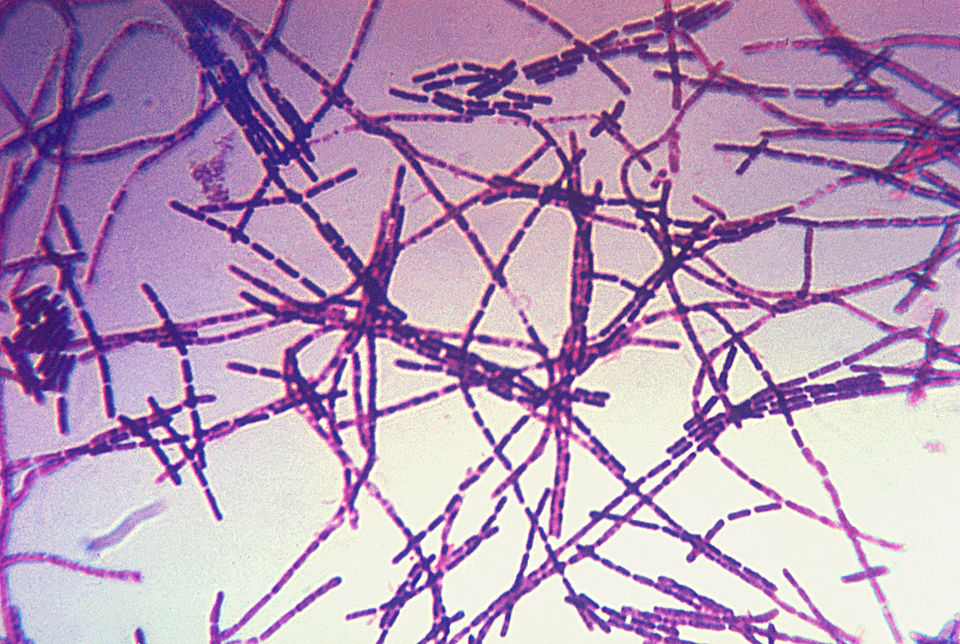
How does anthrax kill? An infection of the anthrax bacteria can kill because the bacteria produce toxins that can kill an animal or a person.
Anthrax is the name for the infection caused by a bacteria called Bacillus anthracis. It is a rod-shaped bacterium that is about 3 to 5 micrometers long. The average human hair is about 75 micrometers wide. On the bacteria scale, though, it is about average. They are able to produce a capsule made of poly-D-glutamic acid that can resist the immune system of any host. These bacteria can get into a host by being eaten, through a cut, or by being breathed in. With animals, the majority of infections come from eating the bacteria. Herbivores can become infected with anthrax more easily because the bacteria can survive in soil as a spore for many decades. Herbivores can pick it up on the grass that they eat. It is less common in carnivores. People can pick it up from animals. People who work with dead animals are more at risk.
People can be infected with anthrax by eating infected meat, by getting the spores on an open wound, by inhaling the spores, or by injecting the spores. Injection is very rare. It happened in Scotland in 2009 when a group of heroin users injected heroin that had been contaminated with anthrax spores during processing in Afghanistan. 14 people died. Infection through a wound in the skin is the most common and accounts for 90% of all cases. It is most often found among people who work with deceased animals or animal products. Eating infected meat can lead to anthrax infection, but only if the meat isn’t cooked properly. If it is well cooked, the bacteria will be killed. Inhalation is the one we are most familiar with because it has been in the news, but it is less common. We have probably heard about it because it is the most dangerous type of infection. When you inhale anthrax spores, they can get to your lymph nodes more quickly and spread around the body much faster. They can also cause lung problems, such as pneumonia, which can then lead to other problems. Inhalation of anthrax is the least common type of infection, though, because it takes a lot of anthrax spores to get through the body’s defenses, and the spores will clump together, making it hard to inhale them deeply enough. You would need between 8,000 and 50,000 spores. Fewer than that and the body can deal with them.
What happens with an anthrax infection? Let’s look at an infection through the skin and an infection through the lungs. When the anthrax bacteria gets into your body through a cut, it attaches to the area and starts to multiply. A blister will form that will become a black ulcer. It won’t be painful because the bacteria release toxins that kill the surrounding tissue, killing the pain receptors at the same time. From here, the anthrax can get into the blood and then to the lymph nodes, although that will take a while. This is the slowest form of infection. If you are infected through inhalation, it is faster. The spores get deep into the lungs and settle in the alveoli, which are the small air sacs in the lungs. The immune system will attack them, but if there are enough, they will spread to the lymph nodes. Once this happens, the lungs will start to fill with fluid, and the person will get chest pain and it will become hard to breathe. There will be a lot of other related symptoms as well, including fever and headaches. Once the infection is noticed, death can follow rapidly, sometimes in as little as 48 hours.
It is not the bacteria that is fatal to animals and us, though. Well, not directly. It is the toxins the bacteria produce that are fatal. They produce three toxins. These are called protective antigen, lethal factor, and edema factor. Each one of these toxins is not lethal on its own. It is a combination of all three that is lethal. The first toxin, the protective antigen, lets the other two toxins into cells. It binds to surface receptors on the cell, then makes a ring shaped pore that the two factors can enter through. The second toxin, lethal factor, disrupts signaling inside the immune cells, impairing them and sometimes killing them. This disruption can cause runaway inflammation, which can lead to septic shock. The third toxin, edema factor, makes cells release fluid. It also increases the effectiveness of the lethal factor toxin. Together, these three toxins are very dangerous.
Anthrax is a bacterial infection and can be cured with antibiotics. However, it needs to be caught early enough. There is also the risk that even if the anthrax bacteria are completely eradicated, the toxins may still be in the system in sufficient amounts to cause death. And this is what I learned today.
Sources
https://pmc.ncbi.nlm.nih.gov/articles/PMC4810214
https://www.cdc.gov/anthrax/bioterrorism/index.html
https://en.wikipedia.org/wiki/Anthrax
https://en.wikipedia.org/wiki/Bacillus_anthracis
https://www.genengnews.com/news/how-anthrax-kills
https://www.cbsnews.com/news/inhalation-anthrax-why-is-it-so-deadly
https://www.mayoclinic.org/diseases-conditions/anthrax/symptoms-causes/syc-20356203
https://www.uchicagomedicine.org/forefront/news/structure-of-anthrax-toxin-offers-clues-to-treatment
Image By Photo Credit:Content Providers(s): CDC – This media comes from the Centers for Disease Control and Prevention’s Public Health Image Library (PHIL), with identification number #2226.Note: Not all PHIL images are public domain; be sure to check copyright status and credit authors and content providers.العربية | Deutsch | English | македонски | slovenščina | +/−, Public Domain, https://commons.wikimedia.org/w/index.php?curid=701357
